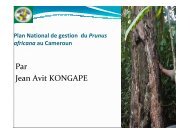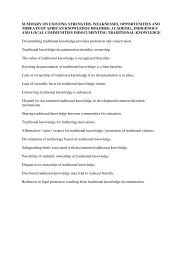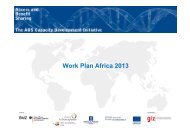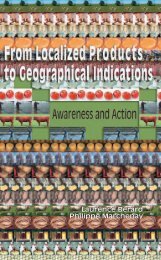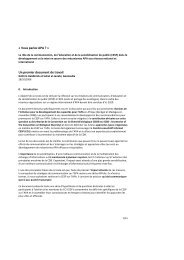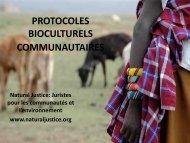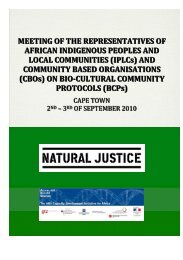The History of Farmers' Rights - Fridtjof Nansens Institutt
The History of Farmers' Rights - Fridtjof Nansens Institutt
The History of Farmers' Rights - Fridtjof Nansens Institutt
Create successful ePaper yourself
Turn your PDF publications into a flip-book with our unique Google optimized e-Paper software.
2 Regine Andersen<br />
To ensure the broadest possible coverage <strong>of</strong> central documents and<br />
literature pertaining to farmers’ rights, we have carried out extensive<br />
searches on the Internet and in various databases, traced reference lists in<br />
available literature and asked stakeholders for recommendations 2 and<br />
received valuable help from several librarians. If we should, despite all<br />
these efforts, have missed a central contribution <strong>of</strong> relevance for farmers’<br />
rights, we would be most grateful for such information. Address:<br />
farmers.rights.project@fni.no.<br />
2 Central documents from international negotiations<br />
<strong>The</strong> first use <strong>of</strong> farmers’ rights as a political concept dates back to the<br />
early 1980s, when Pat Roy Mooney and Cary Fowler 3 coined the term to<br />
highlight the valuable but unrewarded contributions <strong>of</strong> farmers to plant<br />
genetic resources for food and agriculture. 4 <strong>The</strong> idea came up as a countermove<br />
to the increased demand for plant breeders’ rights, as voiced in<br />
international negotiations, to draw attention to the unremunerated innovations<br />
<strong>of</strong> farmers that were seen as the foundation <strong>of</strong> all modern plant<br />
breeding. According to Fowler, 5 the concept can be traced back to the<br />
work <strong>of</strong> inter alia the renowned plant explorer, geneticist and plant<br />
breeder Jack R. Harlan (1917–1988), who spoke <strong>of</strong> farmers as the<br />
‘amateurs’ who had in fact created the genetic diversity that had become<br />
subject to controversies.<br />
2 We received long lists from several <strong>of</strong> the participants in the stakeholder survey<br />
(Background Study 2). From these lists we have selected those contributions,<br />
which we consider <strong>of</strong> direct relevance for farmers’ rights and which have been<br />
published and/or are accessible, for this presentation.<br />
3 Pat Roy Mooney and Cary Fowler founded the Rural Advancement Foundation<br />
International (RAFI) together with Hope Shand in 1977. RAFI was probably the<br />
most influencial NGO during FAO negotiations on crop genetic resources in the<br />
1980s and the early 1990s. Mooney and Shand are still fronting the organization,<br />
which has since changed its name to Action Group on Erosion, Technology and<br />
Concentration (ETC-Group).<br />
4 See Cary Fowler (1994): Unnatural Selection. Technology, Politics and Plant<br />
Evolution (Yverdon, Switzerland: Gordon and Breach), p. 192; and Svanhild-<br />
Isabelle Batta Bjørnstad (2004): Breakthrough for ‘the South’ An Analysis <strong>of</strong><br />
the Recognition <strong>of</strong> Farmers’ <strong>Rights</strong> in the International Treaty on Plant Genetic<br />
Resources for Food an Agriculture, FNI Report 13/2004 (Lysaker, Norway: <strong>The</strong><br />
Fridtj<strong>of</strong> Nansen Institute) p. 35. In 1983, Pat Roy Mooney wrote ‘<strong>The</strong> Law <strong>of</strong> the<br />
Seed: Another Development and Plant Genetic Resources’ (Development Dialogue,<br />
Vol. 1–2, published by the Dag Hammarskjöld Foundation), which is a<br />
comprehensive analysis <strong>of</strong> the international management <strong>of</strong> plant genetic resources<br />
for food and agriculture. Here Mooney argues for benefits to farmers for their<br />
contribution to the global genetic pool, as well as the need for conservation<br />
support. He proposes that a fund be established for the purpose, and argues<br />
against any legal arrangements which may hinder farmers in their practice <strong>of</strong><br />
saving, reusing, improving and developing seeds – in other words, here we find<br />
most <strong>of</strong> the elements which were later to be ascribed to farmers’ rights. See also<br />
G. Kristin Rosendal, 1989: A Sustainable Development for Plant Genetic Resources:<br />
<strong>The</strong> Output <strong>of</strong> the Debate in FAO: a Sisyphean Victory for an Environmental<br />
Organisation R:010-1989 (Lysaker, Norway: <strong>The</strong> Fridtj<strong>of</strong> Nansen Institute).<br />
5 Fowler, 1994, p. 192.





